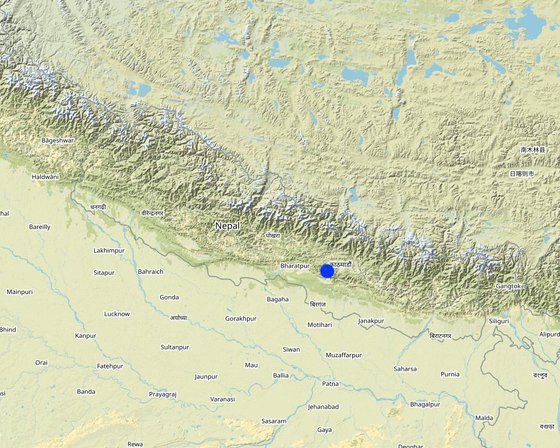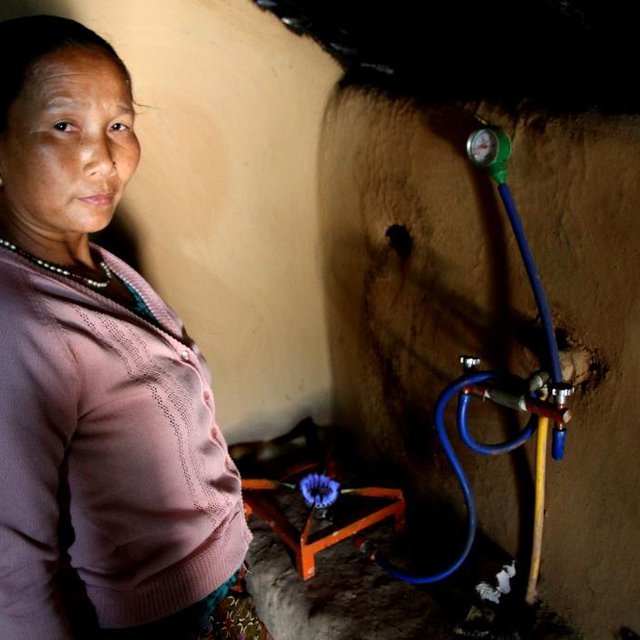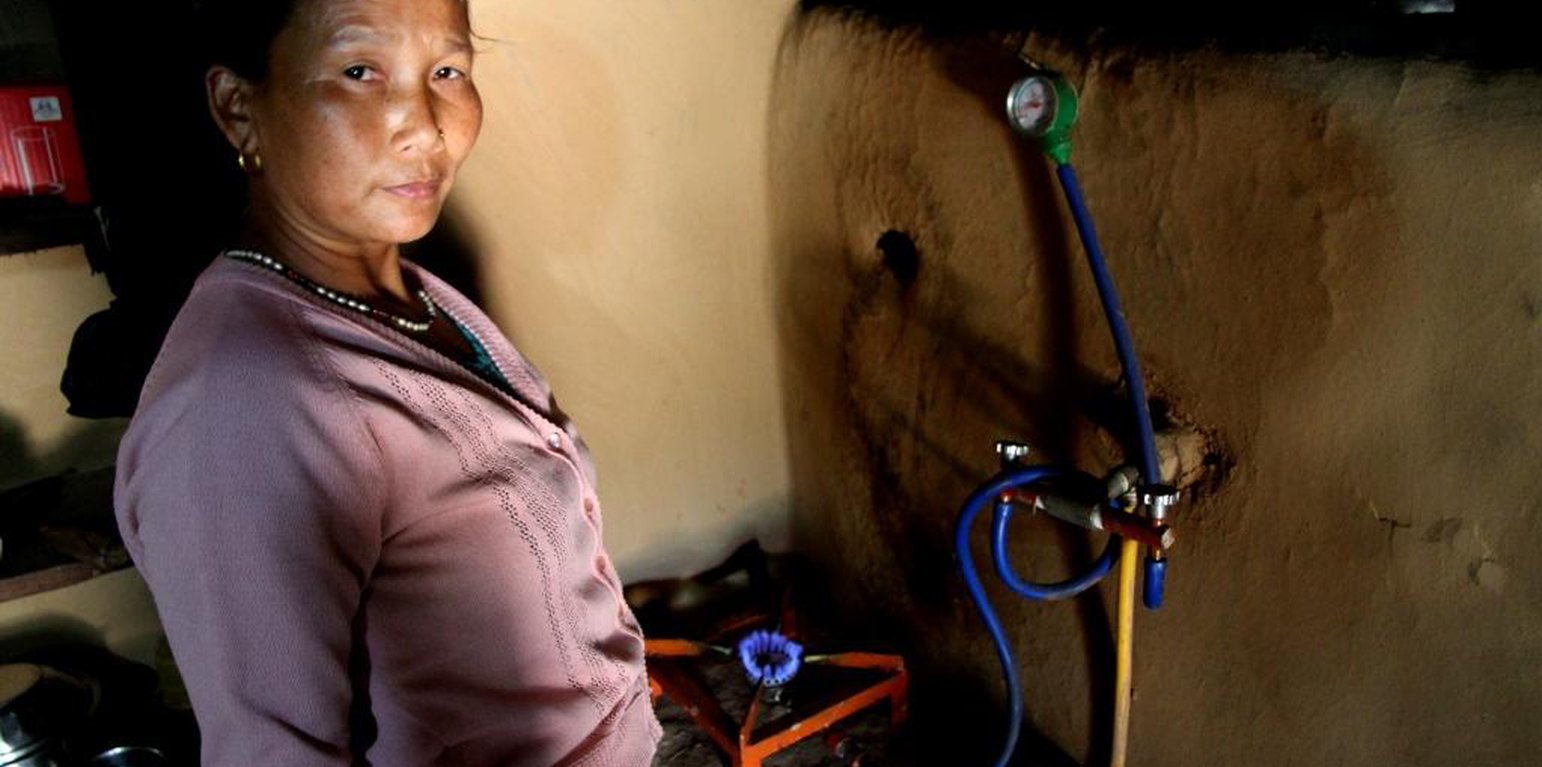Bio-gas
(Nepal)
Gobar gas
Description
Production of fuel from the animal waste.
Aims / objectives: It is used for cooking. It can be also used as compost manure which helps to save money to purchase fertilizer and even for electricity purpose.
Methods: By collecting as much as animal waste.
Stages of implementation: The project was first introduced by the Nether land government and handle to local people and was funded by Dutch Co-operation.
Role of stakeholders: They provide training to the local people
Other important information: It improved the economic status of people by obtaining the cheap fuel.
Location

Location: Kavre, Nepal, Nepal
Geo-reference of selected sites
Initiation date: 2055
Year of termination: 2015
Type of Approach
-
traditional/ indigenous
-
recent local initiative/ innovative
-
project/ programme based

using bio gas plant for cooking food
Approach aims and enabling environment
Main aims / objectives of the approach
The Approach focused mainly on SLM with other activities (cooking,natural waste management ,economic support)
1.To provide economic support.
2.For cooking food.
3.For the management of animal waste.
4.For natural waste treatment.
The SLM Approach addressed the following problems: Deforestation,low agricultural production,health sanitation and indoor pollution
Conditions enabling the implementation of the Technology/ ies applied under the Approach
-
Legal framework (land tenure, land and water use rights): The existing land ownership, land use rights / water rights greatly helped the approach implementation: community ownership meant no hindrance to development.
Conditions hindering the implementation of the Technology/ ies applied under the Approach
-
Social/ cultural/ religious norms and values: No any social problems
Treatment through the SLM Approach: Economically backward group were allowed to pay less as per income as renewal fund.
-
Availability/ access to financial resources and services: Financial problems as the people could not afford the materials.
Treatment through the SLM Approach: But the organization provided the fund for the project.
-
Institutional setting: farmers did not know where to go when they needed advice regarding the procedure and funding required for the biogas production.
Treatment through the SLM Approach: programs were conducted to solve the problems and various institutions were assigned to help farmer if they had to go through any problem
-
Knowledge about SLM, access to technical support: lack of technical knowledge
Treatment through the SLM Approach: training was provided to the people.
Participation and roles of stakeholders involved
Stakeholders involved in the Approach and their roles
| What stakeholders / implementing bodies were involved in the Approach? |
Specify stakeholders |
Describe roles of stakeholders |
| local land users/ local communities |
|
They spread the approach to all the farmers. Since the people were financially aided by the Government as well as other international organisations it helped a bit fot the socially and economically disadvantaged group
|
| SLM specialists/ agricultural advisers |
|
They provide technical education and advices to farmers on the benefits of bio-gas plants. |
| local government |
Village Development Commitee |
|
| national government (planners, decision-makers) |
Agricultural Development bank of Nepal |
The Ministry Of Finance help in the funding for the establishment of biogas plants through their agreement with the Agricultural Development Bank. |
| international organization |
SNV Netherlands Development Organisation |
|
Lead agency
The Netherlands Development Organization helped to develop lower cost bio-gas and the agreement between the Ministry of Finance and SNV Nepal ,Agricultural Development Bank helped to promote and install this bio gas as indigenous and sustainable source of energy and also provided financial aid.
Involvement of local land users/ local communities in the different phases of the Approach
none
passive
external support
interactive
self-mobilization
initiation/ motivation
they interacted with the farmers discussing about the benefits of the bio-gas and how it could reduce their workload of firewood cutting and motivated them to use bio-gas .
planning
They conducted various programs to develop curiosity and anxiousness about the bio-gas production and provided financial aid.
implementation
Implementation was done by helping the farmers to get loan and subsidy from the Government and banks.
monitoring/ evaluation
Monitoring and evaluation was done on the basis of how the new approach has affected the people's livelihood.
Flow chart
The Netherlands Development organisation helped to develop lower cost bio-gas plants .The Ministry of Finance ,the Agricultural Bank of Nepal, Gobar Gas company ,Bio-gas Support Program ,(AEPC) Alternative Energy Promotion Center has really helped in financial help and to promote the bio-gas as the indigenous and sustainable source of energy.
Decision-making on the selection of SLM Technology
Decisions were taken by
-
land users alone (self-initiative)
-
mainly land users, supported by SLM specialists
-
all relevant actors, as part of a participatory approach
-
mainly SLM specialists, following consultation with land users
-
SLM specialists alone
-
politicians/ leaders
Decisions were made based on
-
evaluation of well-documented SLM knowledge (evidence-based decision-making)
-
research findings
-
personal experience and opinions (undocumented)
Technical support, capacity building, and knowledge management
The following activities or services have been part of the approach
-
Capacity building/ training
-
Advisory service
-
Institution strengthening (organizational development)
-
Monitoring and evaluation
-
Research
Capacity building/ training
Training was provided to the following stakeholders
-
land users
-
field staff/ advisers
Form of training
-
on-the-job
-
farmer-to-farmer
-
demonstration areas
-
public meetings
-
courses
Advisory service
Advisory service was provided
-
on land users' fields
-
at permanent centres
Name of method used for advisory service: conducting programs and supplying financial services; Key elements: books were provided , pamplets to promote the service, materials use and procedure methods were taught; financial help was also provided regarding loan subsidies and many others serviec for the farmers to make the service easy to reach.
Advisory service is quite adequate to ensure the continuation of land conservation activities; yes they are adequate because they are the main source of help and their help can make it easy for the promotion throughout the nation.
Institution strengthening
Institutions have been strengthened / established
-
no
-
yes, a little
-
yes, moderately
-
yes, greatly
Describe institution, roles and responsibilities, members, etc.
Type of support
-
financial
-
capacity building/ training
-
equipment
Further details
the local institution were given financial services to provide it to the the local people and farmers
Monitoring and evaluation
bio-physical aspects were regular monitored by land users through observations
bio-physical aspects were regular monitored by land users through measurements
technical aspects were regular monitored by project staff through observations
socio-cultural aspects were regular monitored by other through observations
economic / production aspects were regular monitored by project staff through observations
area treated aspects were regular monitored by project staff through measurements
no. of land users involved aspects were regular monitored by land users through measurements
management of Approach aspects were monitored by None through observations
There were no changes in the Approach as a result of monitoring and evaluation: no,the approach was just to introduce new better ideas .
There were few changes in the Technology as a result of monitoring and evaluation: advancement and improvement in technology was there as a result of monitoring and evaluation.
Financing and external material support
Annual budget in USD for the SLM component
-
< 2,000
-
2,000-10,000
-
10,000-100,000
-
100,000-1,000,000
-
> 1,000,000
Precise annual budget: n.a.
The following services or incentives have been provided to land users
-
Financial/ material support provided to land users
-
Subsidies for specific inputs
-
Credit
-
Other incentives or instruments
Financial/ material support provided to land users
the contributions per area was provided by the private sectors as they provided financial help and other services.
partly financed
fully financed
equipment: machinery
Jar and tank
Labour by land users was
-
voluntary
-
food-for-work
-
paid in cash
-
rewarded with other material support
Impact analysis and concluding statements
Impacts of the Approach
No
Yes, little
Yes, moderately
Yes, greatly
Did the Approach help land users to implement and maintain SLM Technologies?
Since the approach was bio-gas production from animal waste this help in increasing the soil quality very much which led to sustainable land management.It used the resources of the environment which helped a lot in sustainable land management,
Did the Approach empower socially and economically disadvantaged groups?
This approach also helped for job opportunity as the agricultural products get better they can sell it and earn money.
Did the Approach improve issues of land tenure/ user rights that hindered implementation of SLM Technologies?
There was no hindrance.
The problem is likely to be overcome in the near future. The approach creates a framework to use in the future.
Did other land users / projects adopt the Approach?
neighboring village adopt technology. Since it helped to flourish the economic and financial status with very less investment.
Main motivation of land users to implement SLM
-
increased production
-
increased profit(ability), improved cost-benefit-ratio
-
reduced land degradation
-
reduced risk of disasters
-
reduced workload
-
payments/ subsidies
-
rules and regulations (fines)/ enforcement
-
prestige, social pressure/ social cohesion
-
affiliation to movement/ project/ group/ networks
-
environmental consciousness
-
customs and beliefs, morals
-
enhanced SLM knowledge and skills
-
aesthetic improvement
-
conflict mitigation
-
well-being and livelihoods improvement
Sustainability of Approach activities
Can the land users sustain what hat been implemented through the Approach (without external support)?
Conclusions and lessons learnt
Strengths: land user's view
-
it will lead to sustainable land management with less deforestation, and a cleaner environment. (How to sustain/ enhance this strength: the approach should be made accessible to all the individuals.)
Strengths: compiler’s or other key resource person’s view
-
it will help to conserve the energy with the promotion of better environment. (How to sustain/ enhance this strength: Bio-gas production should be adopted by all the communities.)
Weaknesses/ disadvantages/ risks: land user's viewhow to overcome
-
Size of safety tank is too big. They cannot fulfill the requirement of the tank.
Small tank should be constructed.
Weaknesses/ disadvantages/ risks: compiler’s or other key resource person’s viewhow to overcome
-
Methane released cause global warming.
Cannot use chemical in toilet,because it cause environmental hazards.
Approach should be well-constructed.
Avoid the toilet paper.
References
Reviewer
-
Fabian Ottiger
-
Joana Eichenberger
Date of documentation: Jan. 22, 2014
Last update: Julie 13, 2022
Resource persons
-
Sabita Aryal (sabita@ku.edu.np) - SLM specialist
-
Abhishek Singh - SLM specialist
-
Luniva Bajracharya - SLM specialist
-
Priya Kayastha - SLM specialist
-
Baidhaya Rajhuram - SLM specialist
Full description in the WOCAT database
Documentation was faciliated by
Institution
- Kathmandu University (KU) - Nepal
- Sarada Batase Village Development Committee (Sarada Batase VDC) - Nepal
Project





